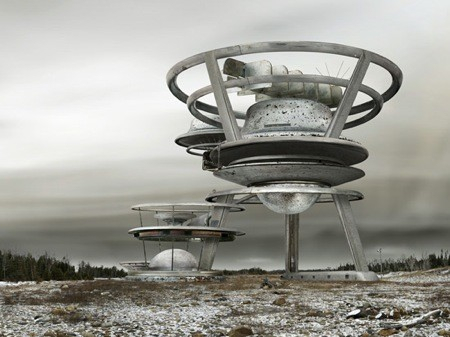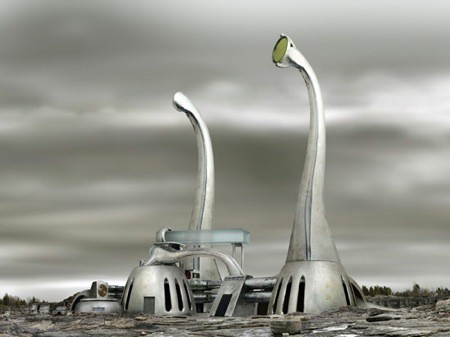
Spyfrost Project Is Cold War redux: David Trautrimas’s Digital Work
There are plenty of chronicles of the post-industrial landscape. Few are as allusively eerie as David Trautrimass. David Trautrimass Spyfrost Project of digital images pictures an unholy miscegenation between the Cold War and the cold landscape. Science may claim to study nature isolated in vitro; the cultural field of vision is more inclusive, if less neat. I looked at Trautrimass new pictures of disembodied industrial parts virtually reassembled into architectures of detection at Photo-Eye Santa Fe; (the gallery has also just published a book of Trautrimass Habitat Machines.)

David Trautrimas "Storm Crown Mechanism"
“NORAD”, these new images whispered. (NORAD for North American Aerospace Defense Command: strings of radars, the Pinetree Line, the McGill Fence and the DEW line, across Canada intended to detect Soviet aircraft and missiles flying high in the freezing skies and low over the tundra and pines.) Civil defense was tabletalk at my house, as a kid. We were fighting the Cold War for rights to grow bluegrass and lespedeza. My parents named me for Joseph CONELRAD, author of the air raid alert system.
Trautrimas in notes cites sources for the parts and locations of his chilly landscapes. Useful background — but the details of these objects and landscapes discovery, collection, and archiving hide within the images the artist has created, his intimacy with their making. In the Seismic Conduction tower the phonograph tone arm becomes part of a sensing structure resembling a rocket. In the Carbon Inversion Device chainsaw parts recycle into a kind a radar set on a lakeshore lined with pines. The radars offhand assembly evokes the ecologically casual slash-buckling of lumberjacks who fell for fossil fuel exploiters and the military system.

David Trautrimas "Micro Re-Instigator"
Storm Crown Mechanism marches on tripod legs up a riverbed like an invader from War of the Worlds. The Micro Re-instigator transforms aluminum castings from the Bausch & Lomb Microbe-buster Instructional microscope into a tentacled architectural zoomorph plaintively stroking the sky.
The Brilliant Device (top photo) carries Trautrimas imagery completely to the zoomorphic. Heavy aluminum polisher castings lying on a rocklined shore read as stranded seals. From their heads emerge the heads of bronzed gauges turned oblique.
Since Trautrimas composes both the objects and the landscapes from multiple images, this bricolage makes his work more like painting from the imagination than like photography, whose root justification is to accurately record real objects and events. The looser sense of assembly than in his earlier Habitat Machines series means a finer line between the parts and the whole. But the field of vision is united by the artists relentless sense of rendering. Look closely at Terra Thermal Inducer, defroster parts thawing a frozen wetland. The detail of the aluminum defroster, the snow where it sits and the forest beyond are equally crystalline. Their equivalent rendering equalizes the importance of setting and building. I think of Late Medieval – Northern Renaissance painters Bosch or Brueghel who painted the background, even into deep space, with clarity and technical detail nearly equal to the foreground.
Trautrimass Spyfrost Project conveys a sense of nature retaking the ruins, like in Rudyard Kiplings Jungle Book. But its not the same nature.
